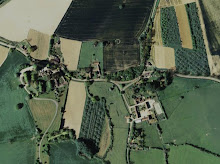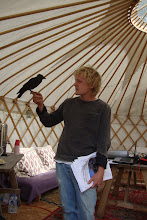
Last Sunday morning I went to Mount Pleasant near Shipston-on-Stour, Warwickshire for a second visit to Roger and Gudrun's fantastic orchard there. At ~4 acres, this non-commercial family orchard has around 220 standard fruit trees and a total of 93 identified varieties of apple, plum, pear and walnut. There is the full range of fruit tree ages, from those planted last year to the original trees from the first planting in about 1850. In other words, its a real treasure trove!

There are several features that make this orchard exceptional, and one of these is the abundance of very ancient apple trees. A sensitive regime of yearly pruning has allowed these trees to become 'over mature' and survive into old age still producing a few good fruit. The veteran tree features found in these trees hold great ecological value and they also develop fascinating twisted shapes. These trees are all Blenheim Orange and probably date from when the orchard was originally all this variety (with a few perry pears as well). It's a local variety that seems to like the heavy clay and makes for delicious eating.

This plum tree is quite bizarre- it is actually made up of two different varieties. The lower branches to the left and right are a wild form of Yellow Bullace (-apparently it is the first tree in the whole orchard to blossom, filling the air with a beautiful almond scent) and the top of the tree is a Blue Pershore. I think that technically you describe the Yellow Bullace as having been 'cuckolded'. This occurred when the Blue Pershore seeded itself in the original tree's crown and then grew down through its trunk.

This eating apple is called a Domino and is unusual on account of its hardness. The apples lie whole on the grass until well into spring and are an invaluable late food source for the overwintering fieldfare.

This is a Russian apple called Emperor Alexander, and one of Roger's favourites.

The illusive and mysterious Orleans Reinette. I have been told by the head of the Cambridge Botanical Gardens that this is best eating apple he's ever tried. Definitely worth a taster in a couple of months...

A multipurpose variety of apple that dates from Roman times called the Quoining. It was still producing until it toppled over this year, so the photos on the right show the tree in 2004 and the strange shape of the fruit. Roger took a graft from the remaining shoots but unfortunately the apples on that look more like a Bramley. Perhaps a second attempt will yield better results.

The orchard has a yearly prune where certain trees are taken in to balance them and minimise toppling or splitting. Recently one of the big original perry pear trees looked like it might split, so here are the before and after pruning shots. Even though it may look quite severe, the tree will quickly recover. This regime of continued maintenance has enabled so many of the trees in this orchard to reach a great age and remain in good condition.

These lumps in the foreground are ant hills of the Yellow Meadow Ant (Lasius flavus) . These ants need a well grazed sward to survive. The size of these ant hills indicates that this land has not been cultivated for a very long time.

The dead wood habitat provided by the orchard is phenomenal. Pruning offcuts are stacked in various places, both beneath trees and in more open areas along the orchard edge. This has provided a great range and abundance of decomposing wood habitats that will support a great diversity of invertebrates. It is a common misconception to assume that wildlife woodpiles must be damp and shaded for maximum benefit- dead wood that is dry and sun-warmed represents and equally valuable and endangered substrate. Gudrun says she can remember seeing stag beetles in the past and the trunk of this perry pear (photographed on the right) shows some evidence of quite large larval bore holes.

This picture says a lot about how well this orchard is managed. By replanting whenever gaps have appeared there is a full range of tree ages, something that is so often lacking in traditional orchards in Britain. Roger takes cuttings from exiting old trees and re-grafts them onto vigorous (M25) rootstocks ensuring they will develop into full size standard trees. This way varieties are preserved and the orchards future is planned for.
.JPG)



No comments:
Post a Comment